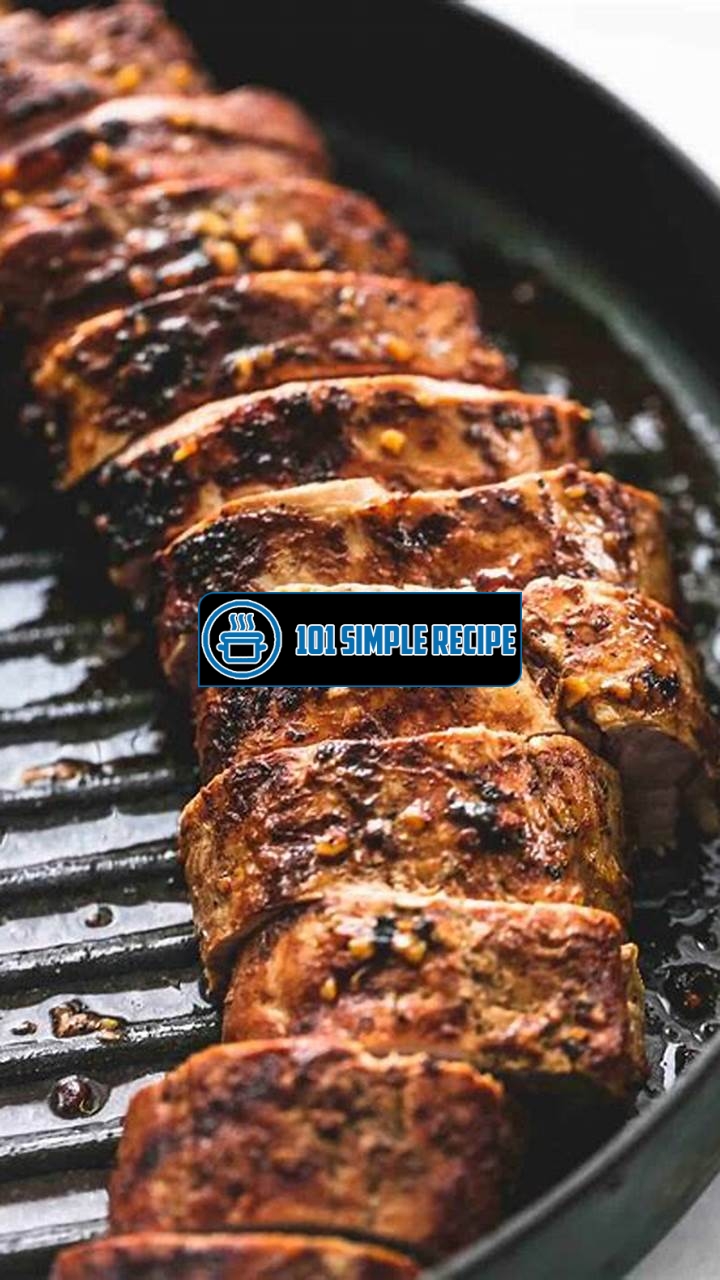Are you tired of serving the same old pork tenderloin dish that lacks flavor and excitement? Look no further because here we reveal the secrets to creating a healthy and delicious pork tenderloin that will impress your family and friends. Whether you’re a seasoned home cook or just starting to explore the culinary world, this article will guide you through the process step by step. From choosing the right cut of pork to marinating it with tantalizing flavors, you’ll learn how to transform a simple piece of meat into a mouthwatering masterpiece. So prepare your kitchen and get ready to unveil the secrets to cooking healthy pork tenderloin!

The Nutritional Benefits of Pork Tenderloin
When it comes to maintaining a healthy diet, including pork tenderloin in your meals can provide you with a wide range of nutritional benefits. This tender and flavorful cut of meat offers a variety of essential nutrients that can support your overall well-being. Let’s explore the key nutritional advantages of incorporating pork tenderloin into your diet.
Lean and Protein-Rich
Pork tenderloin is not only rich in flavor but also an excellent source of lean protein. It is considered one of the leanest cuts of pork available. Protein plays a crucial role in our body, supporting tissue repair, boosting immune function, and promoting the growth and maintenance of muscle mass. Including protein-rich foods like pork tenderloin in your meals can help you feel fuller for longer, prevent overeating, and support healthy weight management.
Furthermore, due to its leanness, pork tenderloin contains low levels of saturated fat. It’s important to choose lean cuts to minimize the intake of unhealthy fats and reduce the risk of cardiovascular diseases. By opting for pork tenderloin as a protein source, you can enjoy the savory taste while keeping your saturated fat intake under control. ️♀️
Rich in Essential Vitamins and Minerals
Pork tenderloin is packed with essential vitamins and minerals that your body needs to function at its best. It is a great source of vitamins B6 and B12, which are vital for brain function, red blood cell production, and energy metabolism. These vitamins also play a role in maintaining healthy hair, skin, and nails. Additionally, pork tenderloin contains significant levels of thiamin, riboflavin, and niacin, which contribute to the proper functioning of the nervous system and help convert food into energy.
When it comes to minerals, pork tenderloin is rich in iron, zinc, and selenium. Iron is necessary for the production of hemoglobin, which carries oxygen in our blood. Zinc is essential for a strong immune system and wound healing. Selenium acts as an antioxidant, protecting our bodies from free radicals and supporting thyroid function. By including pork tenderloin in your diet, you can ensure a good supply of these important minerals.
Low in Sodium and Harmful Fats
An important aspect of maintaining a healthy diet is keeping our sodium intake in check. Excessive sodium consumption can lead to high blood pressure and increase the risk of heart disease. The good news is that pork tenderloin is naturally low in sodium, making it a great choice for individuals who are mindful of their sodium intake.
In addition, pork tenderloin is a low-fat meat. It contains less fat compared to other cuts of pork, making it a healthier option. By choosing pork tenderloin, you can reduce your intake of harmful fats. Remember, moderation is key when it comes to fat consumption, and opting for lean cuts like pork tenderloin allows you to enjoy the meat without compromising your health goals.
Overall, pork tenderloin offers a host of nutritional benefits, including being a lean and protein-rich meat, rich in essential vitamins and minerals, and low in sodium and harmful fats. By incorporating this delicious and nutritious cut of meat into your diet, you can support your overall well-being and enjoy a flavorful meal at the same time.
The Health Implications of Consuming Pork Tenderloin
When it comes to incorporating pork tenderloin into your meals, there are several potential health effects that you should be aware of. This lean and versatile cut of meat not only packs a flavorful punch but also offers numerous benefits for your overall well-being.
Promotes Muscle Growth and Repair
Pork tenderloin contains a high concentration of protein, which is essential for promoting muscle growth and repair. Whether you’re an athlete looking to enhance your performance or simply aiming to build lean muscle mass, including this delicious meat in your diet can be highly beneficial. Protein is composed of amino acids, which are the building blocks of muscle tissue. Thus, consuming pork tenderloin can help to replenish and rebuild your muscles after intense workouts or physical activity.
Protein-packed pork tenderloin aids in muscle growth and repair.
Aids in Weight Management
Contrary to popular belief, pork tenderloin can be a valuable addition to a weight management plan. This tender and juicy meat is relatively low in fat and calories, making it a healthier choice compared to other cuts of pork. Additionally, it is an excellent source of B-vitamins and minerals such as iron and zinc, which play vital roles in metabolism and energy production.
️ Including pork tenderloin in your diet can support weight management and provide essential nutrients.
In fact, studies have shown that consuming lean sources of protein, like pork tenderloin, can help to increase feelings of fullness and reduce appetite, thus aiding in weight loss efforts. This is because protein takes longer to digest, keeping you satisfied for longer periods and reducing the likelihood of overeating or snacking on unhealthy foods.
Boosts Immune Function
Pork tenderloin contains several key nutrients that can help to boost your immune function. It is an excellent source of selenium, a mineral that acts as an antioxidant in the body and helps to defend against damage caused by harmful free radicals. It also provides a significant amount of vitamin B6, which plays a crucial role in supporting immune function and overall health.
Enjoying pork tenderloin can strengthen your immune system and protect against oxidative stress.
Incorporating pork tenderloin into your meals can be an effective way to ensure that you’re getting the necessary nutrients to support your immune system, especially during times when it may be compromised or weakened.
Overall, pork tenderloin offers a range of health benefits, from promoting muscle growth and repair to aiding in weight management and boosting immune function. Including this versatile meat in your diet can help you achieve your health and fitness goals while enjoying delicious and nutritious meals.
How to Select and Prepare Healthy Pork Tenderloin
When it comes to cooking a healthy meal, selecting and preparing the right ingredients is crucial. Pork tenderloin is a lean and flavorful cut of meat that can be a great addition to your diet. By following the best methods to choose and cook pork tenderloin, you can ensure a nutritious and delicious meal. In this article, we will explore how to select and prepare healthy pork tenderloin, covering topics such as choosing high-quality pork tenderloin, marinating and seasoning techniques, and healthy cooking methods.
Choosing High-Quality Pork Tenderloin
Selecting high-quality pork tenderloin is the first step towards cooking a healthy meal. Look for pork tenderloin that is bright pinkish-red in color, with a minimal amount of fat. Avoid any meat that has a grayish color or excessive marbling, as these are signs of poor quality. It is also essential to check the sell-by or use-by date to ensure freshness. Choosing pork from reputable suppliers or local farmers is highly recommended for obtaining the best quality meat.
Note: Choosing high-quality pork tenderloin ensures a flavorful and nutritious meal.
Marinating and Seasoning Techniques
Marinating pork tenderloin before cooking can enhance its flavor and tenderness. You can create a simple marinade by combining ingredients such as olive oil, soy sauce, garlic, and herbs of your choice. Marinate the pork tenderloin for at least 30 minutes to allow the flavors to penetrate the meat. Seasoning the pork tenderloin with herbs and spices before cooking is another way to add depth and taste. Experiment with different combinations of seasonings, such as rosemary, thyme, paprika, or chili powder, to suit your preferences.
Note: Marinating and seasoning the pork tenderloin adds flavor and tenderness to the meat.
Healthy Cooking Methods
When it comes to cooking healthy pork tenderloin, the cooking method plays a significant role. Opt for cooking techniques that require minimal added fat, such as grilling, roasting, or stir-frying. These methods help to retain the natural flavors of the meat without adding unnecessary calories. It is recommended to cook pork tenderloin until it reaches an internal temperature of 145°F (63°C) and then let it rest for a few minutes before slicing. This helps to ensure that the meat is cooked through while remaining tender and juicy.
Additionally, you can incorporate healthy ingredients into your cooking process to enhance the nutritional value of the dish. Consider using olive oil instead of butter or vegetable oil for a healthier fat option. Including a variety of colorful vegetables in your recipe not only adds nutrients but also enhances the presentation of your dish.
Note: Opting for healthy cooking methods ensures a nutritious and delicious pork tenderloin meal.
In conclusion, selecting high-quality pork tenderloin, marinating and seasoning techniques, and healthy cooking methods are essential for cooking a healthy pork tenderloin meal. By following these tips and incorporating healthy ingredients, you can enjoy a nutritious and delicious dish that will impress your taste buds and support your overall well-being.
Delicious and Nutritious Pork Tenderloin Recipes
Looking for new and exciting ways to incorporate healthy pork tenderloin into your meals? Look no further! In this article, we will explore three delectable recipes that showcase the versatility and nutritional value of pork tenderloin. From grilled to stir-fried to oven-roasted, these recipes are sure to satisfy your taste buds and keep you on track with your healthy eating goals.
Grilled Pork Tenderloin with Balsamic Glaze
Fire up your grill and get ready to indulge in a mouthwatering dish of grilled pork tenderloin with a tangy balsamic glaze. This recipe not only packs a punch of flavor but is also a great source of lean protein. To prepare this dish, marinate the tenderloin in a mixture of balsamic vinegar, garlic, olive oil, and a touch of honey for added sweetness. Grill the marinated pork tenderloin until it reaches an internal temperature of 145 degrees Fahrenheit, then let it rest before slicing and serving. The result? Juicy, flavorful, and oh-so-satisfying pork tenderloin that pairs beautifully with grilled vegetables or a fresh salad.
Stir-Fried Pork Tenderloin with Vegetables
Take your taste buds on an adventure with this delicious stir-fried pork tenderloin recipe that is packed with colorful vegetables and Asian-inspired flavors. Start by thinly slicing the pork tenderloin and marinating it in a mixture of soy sauce, ginger, garlic, and a touch of honey. In a hot skillet or wok, stir-fry the marinated pork along with a medley of vibrant vegetables such as bell peppers, broccoli, carrots, and snap peas. The result is a beautifully balanced dish that is not only visually appealing but also loaded with nutrients. Serve this stir-fried pork tenderloin over steamed rice or noodles for a satisfying and complete meal.
Oven-Roasted Pork Tenderloin with Herbs
If you prefer the simplicity of oven cooking, then this recipe for oven-roasted pork tenderloin with herbs is perfect for you. This fuss-free method allows the flavors to meld together while the pork cooks to tender perfection. To prepare this dish, rub the pork tenderloin with a mixture of your favorite herbs, such as rosemary, thyme, and garlic powder. Place the seasoned pork on a baking sheet and roast it in a preheated oven at 425 degrees Fahrenheit for about 20-25 minutes or until the internal temperature reaches 145 degrees Fahrenheit. The result? A succulent and flavorful pork tenderloin that pairs well with roasted vegetables or a side of mashed potatoes.
With these three tantalizing recipes, you now have the tools to create healthy and delicious meals featuring pork tenderloin as the star ingredient. Whether you choose to grill, stir-fry, or roast your pork tenderloin, each recipe offers a unique and satisfying culinary experience. So go ahead, unleash your inner chef, and discover the endless possibilities of cooking with this lean and tasty cut of meat. Your taste buds and your body will thank you!
Additional Tips for Incorporating Pork Tenderloin into a Balanced Diet
When it comes to cooking healthy pork tenderloin, there are a plethora of options to explore. Pork tenderloin is a lean cut of meat that is not only delicious but also versatile. By incorporating it into your daily meals, you can ensure that your diet remains well-rounded and packed with nutrients. Here are some practical tips and ideas for making the most out of this flavorful meat:
Pairing Pork Tenderloin with Fresh Produce
One of the easiest ways to amp up the nutrition factor of your pork tenderloin dishes is by pairing them with fresh produce. Vegetables and fruits not only add vibrant colors to your plate but also provide essential vitamins and minerals that contribute to a balanced diet. Consider adding a side of steamed broccoli or roasted Brussels sprouts to complement the flavors of your pork tenderloin. The addition of colorful bell peppers or juicy pineapple can also add a refreshing twist to your meals.
Creating Balanced Meals with Pork Tenderloin
In order to create a well-balanced meal, it’s important to include a variety of food groups. When working with pork tenderloin, you can opt for a three-component meal by incorporating lean protein, whole grains, and non-starchy vegetables. For instance, you can serve grilled pork tenderloin slices alongside a quinoa and vegetable salad. This combination provides a healthy dose of protein, complex carbohydrates, and fiber, ensuring that your meal is both satisfying and nutritious.
Furthermore, don’t forget about the importance of healthy fats. Consider marinating your pork tenderloin in olive oil or top your cooked meat with avocado slices. These healthy fats not only add flavor but also contribute to heart health. Remember, a balanced diet is all about incorporating different food groups and nutrients in appropriate portions.
Modifying Recipes for Dietary Restrictions
For individuals with dietary restrictions or specific health concerns, it’s important to modify recipes to suit their needs. Whether you’re following a low-sodium, gluten-free, or dairy-free diet, there are plenty of ways to enjoy pork tenderloin while staying on track with your goals. For example, instead of using traditional breadcrumbs to coat your pork tenderloin, you can opt for gluten-free alternatives such as almond flour or cornmeal. Additionally, if you’re watching your sodium intake, you can experiment with flavorful herbs and spices to season your meat instead of relying on salt.
Remember, the key to cooking healthy pork tenderloin lies in being creative and open to new ideas. By incorporating fresh produce, creating balanced meals, and modifying recipes to suit your dietary needs, you can fully enjoy this lean and delicious meat while maintaining a well-rounded diet. So go ahead and explore the many possibilities that pork tenderloin has to offer!
Thank you for taking the time to read this article about healthy pork tenderloin. We hope you found it informative and helpful in your quest for delicious and nutritious meals. Whether you’re a seasoned cook or just starting out in the kitchen, pork tenderloin is a versatile option that can be enjoyed in many different ways. From marinating and grilling to roasting and stir-frying, there’s a recipe out there to suit everyone’s taste preferences. So why not bookmark this page and come back to it later when you’re in need of some culinary inspiration? Until then, happy cooking and bon appétit!
Frequently Asked Questions
Here are some frequently asked questions about healthy pork tenderloin:
| No. | Questions | Answers |
|---|---|---|
| 1. | Is pork tenderloin a healthy meat option? | Yes, pork tenderloin is considered one of the leanest cuts of pork and can be a nutritious addition to a balanced diet. It is low in fat, high in protein, and a good source of important vitamins and minerals. |
| 2. | What is the best way to cook pork tenderloin? | There are several methods to cook pork tenderloin, including roasting, grilling, and stir-frying. The best cooking method depends on your personal preferences and the flavors you want to achieve. It’s important to cook pork tenderloin to the proper internal temperature to ensure it is safe to eat. |
| 3. | How long should I cook pork tenderloin? | The cooking time for pork tenderloin can vary depending on the size and cooking method. As a general guideline, it typically takes about 20-30 minutes to cook pork tenderloin in a 425°F (220°C) oven. However, it’s always best to use a meat thermometer to ensure it reaches an internal temperature of 145°F (63°C) for safe consumption. |
| 4. | What are some marinade options for pork tenderloin? | There are endless possibilities when it comes to marinating pork tenderloin. Some popular options include teriyaki, honey mustard, garlic and herb, and balsamic vinegar. Experiment with different flavors to find your favorite combination! |
| 5. | Can I freeze pork tenderloin? | Yes, you can freeze pork tenderloin. Make sure to wrap it tightly in plastic wrap or place it in a freezer-safe bag to prevent freezer burn. It can be stored in the freezer for up to six months. Thaw it in the refrigerator before cooking. |
| 6. | What are some serving suggestions for pork tenderloin? | Pork tenderloin can be served with a variety of side dishes, such as roasted vegetables, mashed potatoes, or a simple salad. It pairs well with a wide range of flavors, so feel free to get creative with your meal combinations! |
Closing Thoughts
We hope this article has inspired you to incorporate healthy pork tenderloin into your cooking repertoire. With its lean profile and versatility, it’s a fantastic option for creating delicious and nutritious meals. Whether you’re grilling up a tenderloin for a summer barbecue or roasting it with your favorite herbs and spices, pork tenderloin is sure to please your taste buds. Remember to bookmark this page for future reference and visit us again soon for more culinary inspiration. Stay healthy and happy cooking!
Jump to Recipe
Healthy Pork Tenderloin

Discover how to cook a healthy pork tenderloin and explore various recipes!
- 1 pork tenderloin
- 2 tablespoons olive oil
- 1 tablespoon balsamic vinegar
- 1 teaspoon dried rosemary
- Salt and pepper to taste
- Preheat the oven to 425°F (220°C) and line a baking sheet with parchment paper.
- In a small bowl, whisk together the olive oil, balsamic vinegar, dried rosemary, salt, and pepper.
- Place the pork tenderloin in a shallow dish and pour the marinade over it. Make sure the tenderloin is coated evenly. Let it marinate for at least 30 minutes, or refrigerate overnight for maximum flavor.
- Transfer the marinated pork tenderloin to the prepared baking sheet. Roast in the preheated oven for 20-25 minutes, or until the internal temperature reaches 145°F (63°C).
- Remove the pork tenderloin from the oven and let it rest for 5 minutes before slicing. This allows the juices to redistribute for a tender and flavorful result.
- Serve the sliced pork tenderloin with your favorite side dishes and enjoy a healthy and delicious meal!






